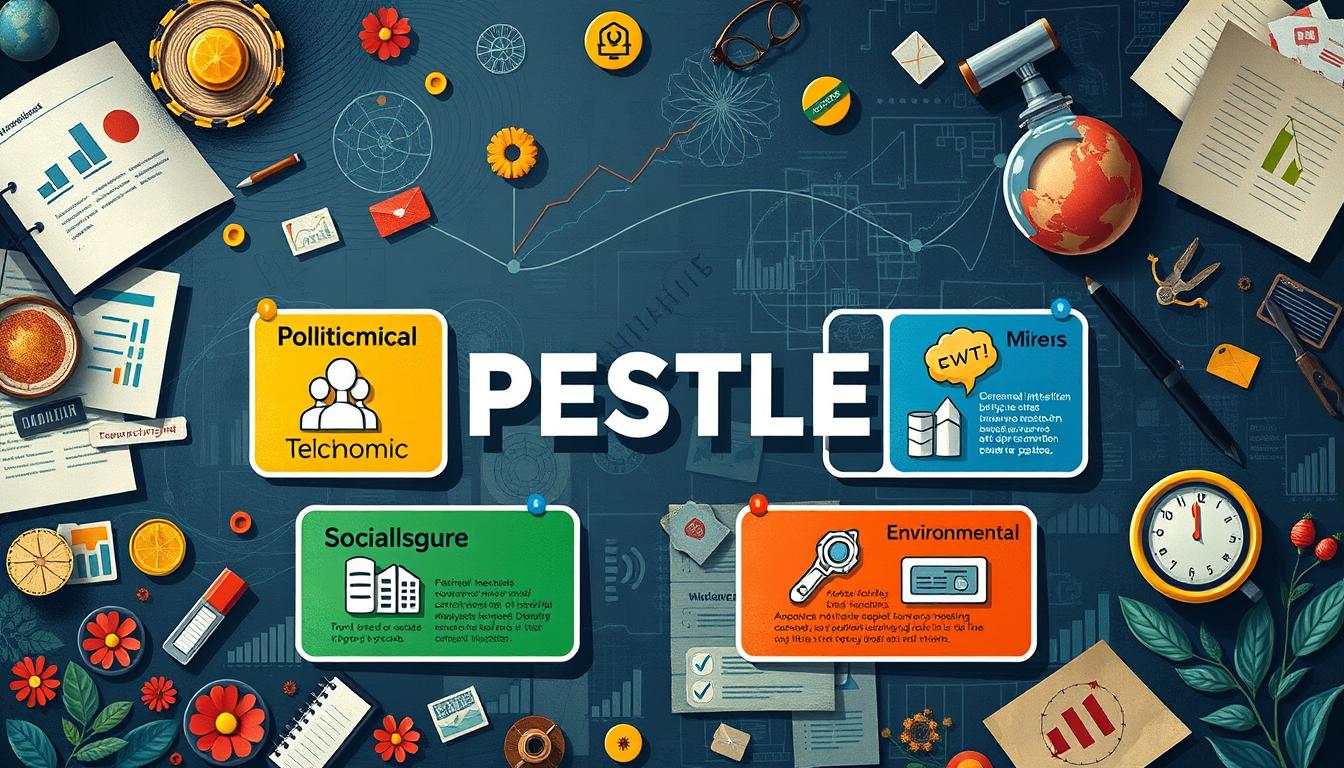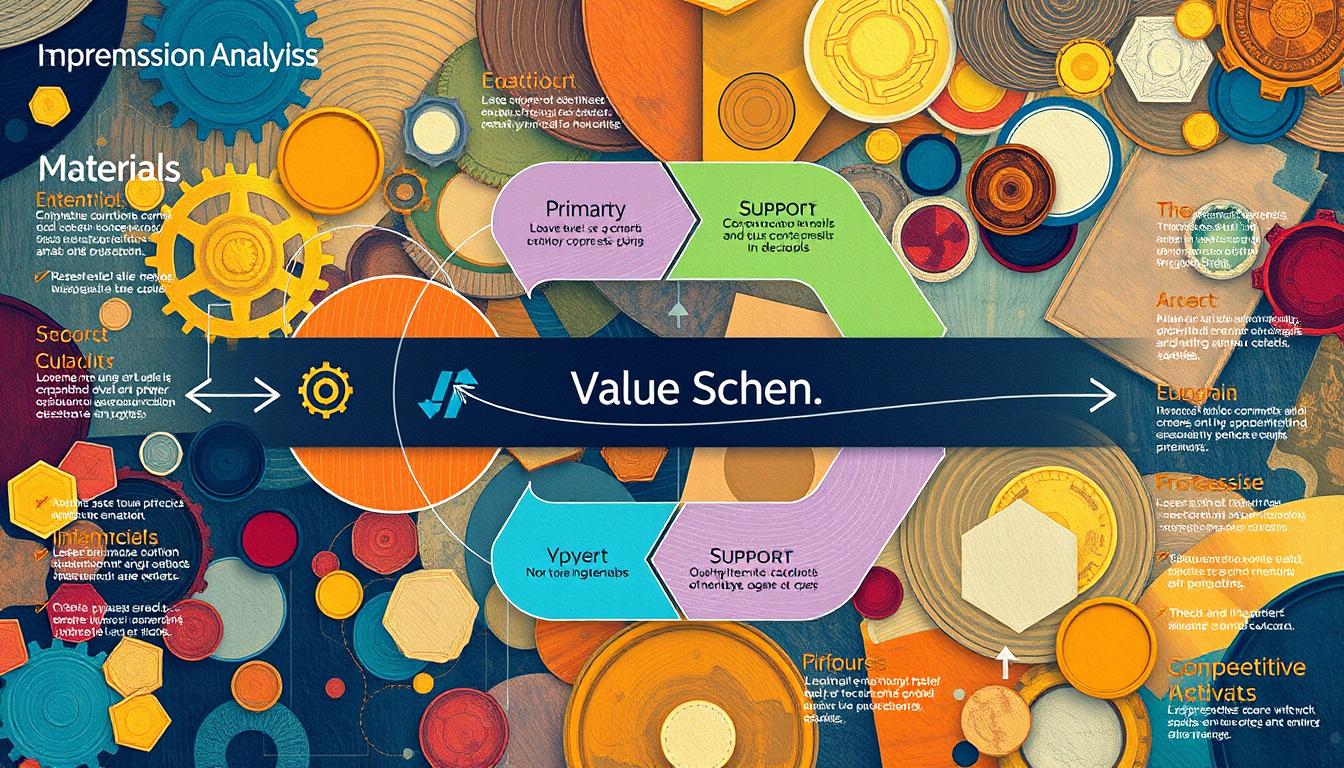Did you know over 90% of top global companies use PESTLE analysis to understand markets and make smart choices1? This tool looks at Political, Economic, Social, Technological, Legal, and Environmental factors. It helps businesses tackle tough market challenges and spot new chances.
PESTLE analysis is key in planning strategies, involving top managers and leaders1. It helps businesses find out what might harm them, what they can do better, and how to succeed in changing markets.
PESTLE analysis covers everything from political stability to tech changes and green rules1. It gives a full view of what’s outside a company that affects its success and growth. This way, businesses can make better choices, avoid risks, and aim for lasting success.
Key Takeaways
- PESTLE analysis is a widely adopted strategic tool for assessing macro-environmental factors impacting businesses.
- The framework covers Political, Economic, Social, Technological, Legal, and Environmental dimensions to identify threats and opportunities.
- PESTLE analysis is a key part of planning strategies, involving senior leaders and key stakeholders.
- Using PESTLE analysis helps businesses deal with complex market issues and make smart, data-based choices.
- Keeping PESTLE analysis up to date helps companies stay on top of changing external factors.
Understanding the Fundamentals of PESTLE Analysis
The PESTLE framework has grown from the PEST analysis to include Environmental and Legal factors. This gives a full view of the outside forces that affect a company’s strengths and weaknesses2. It helps businesses keep up with market changes and stay ahead by showing key areas that shape the business world3.
Origins and Evolution of PESTLE Framework
The PESTLE framework started with the PEST analysis, focusing on Political, Economic, Social, and Technological factors3. It has grown to include Environmental and Legal aspects. This shows how important sustainability and following the law are in today’s business2.
Core Components and Their Significance
The PESTLE framework looks at six main factors that affect the business world:2
- Political factors, like government rules, taxes, and trade laws
- Economic factors, including interest rates, inflation, and currency values
- Social factors, covering population trends, cultural values, and how people shop
- Technological factors, focusing on new tech, research, and online safety
- Environmental factors, dealing with green issues, climate change, and using resources wisely
- Legal factors, including rules for industries, work laws, and protecting ideas
Understanding these factors helps businesses make better choices and keep up with market changes3.
Strategic Importance in Modern Business
The PESTLE framework is key for planning and making decisions in today’s business world3. It helps companies see changes coming, find new chances, handle risks, and make choices based on facts3. By looking at the wider world, businesses can get an edge, follow the law, and grow in a green way2.
“PESTLE analysis is a key tool for adapting, growing, managing risks, innovating, and making better choices in the changing business world.”
| PESTLE Component | Key Considerations |
|---|---|
| Political | Government policies, taxation, trade regulations, antitrust issues |
| Economic | Interest rates, employment, inflation, exchange rates, financial indicators |
| Social | Demographics, lifestyle trends, consumer beliefs, attitudes toward working conditions |
| Technological | Automation, R&D, technology infrastructure (5G, IoT), cybersecurity |
| Environmental | Carbon footprint, climate change, extreme weather, natural resource management |
| Legal | Industry regulations, employment laws, intellectual property protection |
The PESTLE framework helps businesses deal with the complex and changing business world. It’s vital for adapting, growing, managing risks, innovating, and making better choices32.
Political Factors: Government Policies and Regulations Impact
In the PESTLE framework, political factors are key in shaping the business world4. They include things like regulatory rules, trade tariffs, and government help. These can greatly affect how businesses manage their products and make big decisions4. It’s important for companies to watch the political scene closely. Changes in government rules, leadership, and trade deals can really impact their work, supply chains, and how they enter new markets45.,
Knowing the political climate is vital for companies to deal with complex rules and find chances or challenges5. Keeping up with the latest political news, like new laws or trade policy changes, helps companies adjust their plans. This way, they can take advantage of new trends46.,
| Political Factors | Impact on Businesses |
|---|---|
| Government Policies | Compliance requirements, tax laws, subsidies, and trade regulations |
| Political Stability | Influence on investment, economic growth, and market access |
| Foreign Trade Agreements | Tariffs, import/export barriers, and supply chain implications |
By doing a deep PESTLE analysis, companies can really understand the political scene and its effects on them5. This knowledge helps them make smart choices, avoid risks, and grab chances in the changing business world46.,

“Effective political analysis is essential for businesses to navigate the complex regulatory environment and identify possible opportunities or challenges.”
Economic Indicators and Market Dynamics
Understanding economic indicators and market dynamics is key for businesses to succeed7. PESTLE Analysis looks at six areas, including economic factors that affect consumer behavior and business success7. These factors, like inflation and unemployment, shape market trends and guide strategic decisions7.
Global Economic Trends Analysis
By watching global economic trends, businesses can prepare for market shifts and adjust their plans8. Companies that use PESTLE analysis do so for planning, risk management, research, and compliance8. They focus on economic growth, inflation, and unemployment, among other factors8.
Market Growth Patterns
Studying market growth patterns helps spot new chances and hurdles7. Companies that saw climate change’s impact early have moved to greener practices7. This knowledge helps them seize market trends and make smart decisions about growth7.
Financial Indicators Assessment
Looking at financial indicators gives insights into the market’s health7. PESTLE Analysis helps businesses spot risks and opportunities, guiding decisions on market entry and product launches7. By tracking financial metrics, companies can grasp market performance and tweak their strategies7.
| Economic Factor | Percentage of Businesses Considering |
|---|---|
| Economic Growth | 82% |
| Inflation Rates | 70% |
| Exchange Rates | 61% |
| Interest Rates | 48% |
| Unemployment Levels | 41% |
By using economic analysis, market trends, and financial indicators, businesses can make better strategic choices7. This detailed approach, as shown in the PESTLE framework, helps companies navigate the economic world and grow sustainably7.
Social and Demographic Trends Shaping Markets
Understanding the changing social scene and demographic shifts is key for businesses. Social factors like population, consumer attitudes, and lifestyle trends shape how people buy and what they want. These trends are important for businesses to know9.
Demographic factors like age, gender, race, and household size affect what people like to buy and how loyal they are to brands. By studying these trends, companies can make their products and marketing better fit what their customers want9.
Also, changes in society, like more focus on the environment, push companies to be greener. By keeping up with social analysis and demographic trends, businesses can grab new chances for growth9.

| Demographic Factors | Impact on Market |
|---|---|
| Aging Population | Increased demand for healthcare, retirement services, and leisure activities |
| Rising Urbanization | Growing need for urban infrastructure, transportation, and housing |
| Changing Family Structures | Evolving demand for household products, childcare services, and education |
“Understanding the social and demographic landscape is no longer a nice-to-have, but a strategic imperative for businesses looking to stay ahead of the curve.”
By tackling these social analysis and demographic trends head-on, companies can spot new chances for growth10.
But, social analysis and demographic trends are complex and change fast. Businesses need to keep up and adapt quickly to stay competitive10.
Leveraging Social and Demographic Insights
To make the most of social analysis and demographic trends, businesses can try several things:
- Do deep market research to get to know what their customers like and do
- Use customer segmentation and personalization to make products and marketing fit better
- Work with industry experts to stay on top of new trends
- Keep their business plans up to date with the changing market
By being proactive and using data, businesses can find new ways to innovate and succeed in a changing market109.
Technological Advancements and Digital Transformation
In today’s fast-changing business world, understanding technology and digital change is key for staying ahead. The rise of e-commerce platforms has changed retail, making online sales and digital marketing a must11. Businesses must follow data protection laws, like GDPR, when handling customer data11. Also, growing awareness of climate change pushes companies to be more eco-friendly and cut their carbon footprint11.
Emerging Technologies Impact
The effect of new technologies on business is huge12. Governments worldwide push for digital change to boost growth, and data protection laws shape digital solutions12. Digital transformation will create a lot of value, but it might also widen income gaps between companies that adapt and those that don’t12. New tech like AI, IoT, 5G, and quantum computing are changing how businesses work, but cybersecurity threats are growing too12.
Digital Innovation in Market Research
Digital innovation is key in market research12. Fast tech progress and global connections have sped up change, and people are moving to digital platforms12. The pandemic has made remote work and digital tools more common, changing work culture12. AI and automation might replace some jobs but also create new ones, showing the need for constant learning and adaptability12.
Technology Adoption Patterns
Knowing how people adopt technology is vital for businesses in the digital world12. Laws on intellectual property, cybersecurity, and digital rights are getting more attention, and digital adoption can help manage resources better12. Companies that don’t keep up with digital changes risk being left behind, as digital transformation will bring huge economic benefits12.
| Technological Factors | Impact |
|---|---|
| E-commerce Platforms | Transforming the retail industry, requiring businesses to adopt online sales channels and digital marketing strategies11. |
| Data Protection Regulations | Crucial for businesses handling customer data, such as the General Data Protection Regulation (GDPR)11. |
| Climate Change Awareness | Driving businesses to implement eco-friendly practices and reduce their carbon footprint11. |
| Emerging Technologies | AI, IoT, 5G, and quantum computing are revolutionizing business operations, while cybersecurity threats are on the rise12. |
| Digital Transformation | Governments are encouraging it to drive growth, with regulations impacting how businesses approach digital solutions. The economic value created will be immense, but there is a potentially for increased income disparity12. |
“Companies that don’t evolve digitally risk becoming obsolete, as the economic value created by digital transformation will be immense.”12
As businesses face the changing tech world, a deep technological analysis and a smart digital strategy are key for innovation and staying competitive. By keeping up with new trends and changing laws, companies can thrive in the digital age.
Legal Framework and Regulatory Compliance
When doing a PESTLE analysis, the legal part is key. It helps us see how laws affect a business13. Laws cover many areas, like health and safety, and consumer rights. Businesses must follow these to avoid legal trouble14.
Knowing the laws is vital for staying ahead in the market14. The legal analysis part of PESTLE helps businesses get ready for law changes. They can then adjust their plans and follow the rules14.
Looking closely at legal and regulatory compliance helps businesses get ready for legal issues. They can find new chances in business law and keep their business strong14.
“Effective legal analysis through PESTLE is key for dealing with today’s business world. It helps companies succeed over time.”
Adding legal analysis to PESTLE helps businesses make smart choices. They can lower legal risks and grow in a changing world14.
Environmental Considerations in Market Analysis
As the world focuses more on the environment, businesses must think about it too15. They need to look at the availability of raw materials, pollution goals, and how to be more sustainable15. It’s also important to consider the short and long-term effects of environmental changes15.
By adapting to green rules and what customers want, companies can find new chances to grow15.
Sustainability Trends
Sustainability is key in today’s business world16. Companies should watch for trends like renewable energy and the circular economy15. Being green can help a company’s image and open up new money-making chances.
Environmental Regulations Impact
Green laws are changing, and this affects businesses9. Following these laws is a must to avoid big fines9. But, companies that follow these rules can stand out as leaders in being green.
Green Business Opportunities
The focus on being green has created many new business chances9. From clean energy to eco-friendly products, there’s a lot to explore15. By focusing on green, companies can stand out and help the planet.
| Environmental Factor | Potential Opportunities | Potential Threats |
|---|---|---|
| Renewable Energy | Developing solar, wind, or hydropower solutions | Dependence on government subsidies or incentives |
| Circular Economy | Offering recycling, reuse, or refurbishment services | Adapting to changing consumer preferences |
| Sustainable Packaging | Designing biodegradable or compostable packaging | Complying with evolving packaging regulations |
By looking at the environment in their market analysis, businesses can understand the market better16. This helps them make smart choices and find chances in the green sector9.
“The future of business is green. Companies that embrace sustainability and environmental stewardship will thrive, while those that ignore it will be left behind.”
PESTLE Analysis: A Complete Guide for Market Research
PESTLE analysis is a key tool for deep market research. It helps businesses understand the outside factors that affect them. By looking at Political, Economic, Social, Technological, Legal, and Environmental (PESTLE) aspects, companies get a full view of their surroundings. This helps them spot dangers and chances17.
This framework offers a clear way to study the complex outside forces. Unlike simple research methods, PESTLE analysis looks at more, helping businesses make better choices. This includes deciding when to enter a market, launch a product, or grow17.
Political factors like laws and taxes can really change how a company does business18. Economic factors like interest rates and inflation also matter a lot. They affect how much people can spend and the market’s overall health18. By using PESTLE, companies can better prepare for these changes.
Technology and digital changes are also key in the market18. New tech can shake up old ways of doing things, bringing both problems and chances. Adding these tech aspects to PESTLE helps businesses stay on top of new trends.
PESTLE analysis is a detailed way to guide business decisions in today’s fast-changing world17. It helps companies plan well and succeed over time17.
In today’s fast and connected business world, PESTLE is a key tool for planning and making decisions17. It helps businesses understand the complex outside world. This way, they can make smart choices, avoid risks, and grab new chances17.
“PESTLE analysis lets us see the big picture and make smart, strategic choices for lasting growth and success.” – Miloriano.com Expert
Implementing PESTLE Analysis in Strategic Planning
Adding PESTLE analysis to your strategic planning is key for making smart choices19. This tool helps you see the political, economic, social, technological, environmental, and legal factors affecting your business. It lets you spot chances and avoid dangers by looking at these outside forces closely.
Data Collection Methods
Getting the right data is the first step for a good PESTLE analysis20. You can use many ways to collect data, like market research, reports, talking to experts, and looking at your own data19. These methods give you the info you need to make smart plans.
Analysis Techniques
After you have your data, you need to sort and study it20. You should figure out which factors are most important and how they might affect your goals19. Knowing this helps you make plans that work well and keep risks low.
Strategic Implementation Steps
The last step is to turn what you’ve learned into real plans19. You’ll make detailed plans, decide how to use your resources, and set goals to check if your plans are working20. Keeping your analysis up to date helps your plans stay on track with the changing world.
Using the PESTLE framework helps your strategic planning, data analysis, and implementation strategies get better1920. This way, your business can succeed in today’s fast-changing market.
Conclusion
PESTLE analysis is key for companies to deal with the changing business world. This detailed method looks at big factors like politics, economy, society, technology, environment, and law. These factors help shape a company’s plans and its place in the market21.
Doing PESTLE analysis often helps businesses spot dangers and chances. It lets them create plans that match the market’s moves21. Even though it has some downsides, like being open to interpretation and needing updates, it offers deep insights. These insights help in making smart choices and gaining an edge, mainly in fast-changing, global markets22.
In today’s complex world, using PESTLE analysis helps companies face challenges and make informed decisions. By grasping the complex mix of political, economic, social, technological, legal, and environmental factors, businesses can adjust their strategies. They can also grab new market chances and grow stronger over time22.
FAQ
What is PESTLE analysis?
What are the key components of PESTLE analysis?
Why is PESTLE analysis important for businesses?
How can businesses use PESTLE analysis for strategic planning?
What are the key steps in implementing PESTLE analysis?
Source Links
- PESTLE Analysis, PESTLE Analysis Template – GroupMap – https://www.groupmap.com/portfolio/pestle-analysis
- PESTEL Analysis – https://corporatefinanceinstitute.com/resources/management/pestel-analysis/
- What is a PESTEL Analysis? Definition, Examples | Appinio Blog – https://www.appinio.com/en/blog/market-research/pestel-analysis
- PESTLE Analysis: A Strategic Framework for Product Managers – Beyond the Backlog – https://beyondthebacklog.com/2024/12/09/pestle-analysis/
- PESTLE Analysis – (Intro to Marketing) – Vocab, Definition, Explanations | Fiveable – https://fiveable.me/key-terms/fundamentals-marketing/pestle-analysis
- Marketing Theories – PESTEL Analysis – https://www.professionalacademy.com/blogs/marketing-theories-pestel-analysis/
- PESTLE Analysis: A Comprehensive Framework for Business Strategy – https://www.linkedin.com/pulse/pestle-analysis-comprehensive-framework-business-pathan-irfan-khan-6zypc
- Understanding PESTLE Analysis: A Complete Guide – https://www.spocket.co/glossary/pestle-analysis-political-economic-social-technological-legal-environmental?srsltid=AfmBOorEhxUf7aKO5ykXKnBzRyVTPZiIn9uYowcrbS-Odx_jCGO5ryAN
- Using PESTLE Analysis in Strategic Planning | SafetyCulture – https://safetyculture.com/topics/pestle-analysis/
- Understanding PESTLE Analysis: A Complete Guide – https://www.spocket.co/glossary/pestle-analysis-political-economic-social-technological-legal-environmental?srsltid=AfmBOopFIOEtdMD4f_zOy8yKJjKYb32ZHLn1VNmohccFCNQ8AsQ2rx4v
- PESTLE Analysis – https://www.msicertified.com/blog/pestle-analysis/
- PESTLE Analysis on Digital Transformation and the Future of Work by Kelly Dowd – https://www.linkedin.com/pulse/pestle-analysis-digital-transformation-future-work-kelly-dowd-mba
- What is PESTEL Analysis? Definition, Benefits and Best Practices – https://ideascale.com/blog/what-is-pestel-analysis/
- Understanding PESTLE Analysis: A Complete Guide – https://www.spocket.co/glossary/pestle-analysis-political-economic-social-technological-legal-environmental?srsltid=AfmBOoom8EHJMjACJmfiej4DRXU9OYIPcZgOspgnFv-kdVgn237Wuc4d
- How to Conduct a PESTLE Analysis – https://www.ibisworld.com/blog/3-step-pestle-analysis/99/1127/
- How to create a PESTLE analysis for marketing planning | Smart Insights – https://www.smartinsights.com/digital-marketing-strategy/how-to-create-a-pestle-analysis-for-marketing-planning/
- PESTEL Framework: The 6 Factors of PESTEL Analysis – https://pestleanalysis.com/pestel-framework/
- What is PESTLE analysis? Excellent Business Analysis Tool – https://www.marketing91.com/pestle-analysis/
- Comprehensive Guide [Updated for 2025] – https://bscdesigner.com/pestel-analysis.htm
- Performing a PESTLE Analysis for Strategic HR Planning – https://www.tmi.org/blogs/performing-a-pestle-analysis-for-strategic-hr-planning
- How to do PESTEL Analysis (with examples, template and AI) – https://www.stratnavapp.com/Articles/PESTEL
- Introduction to PESTLE Analysis: Why a Systemic Approach is Best — Bâton Global – https://www.batonglobal.com/post/introduction-to-pestle-analysis-and-why-a-systemic-approach-is-best










